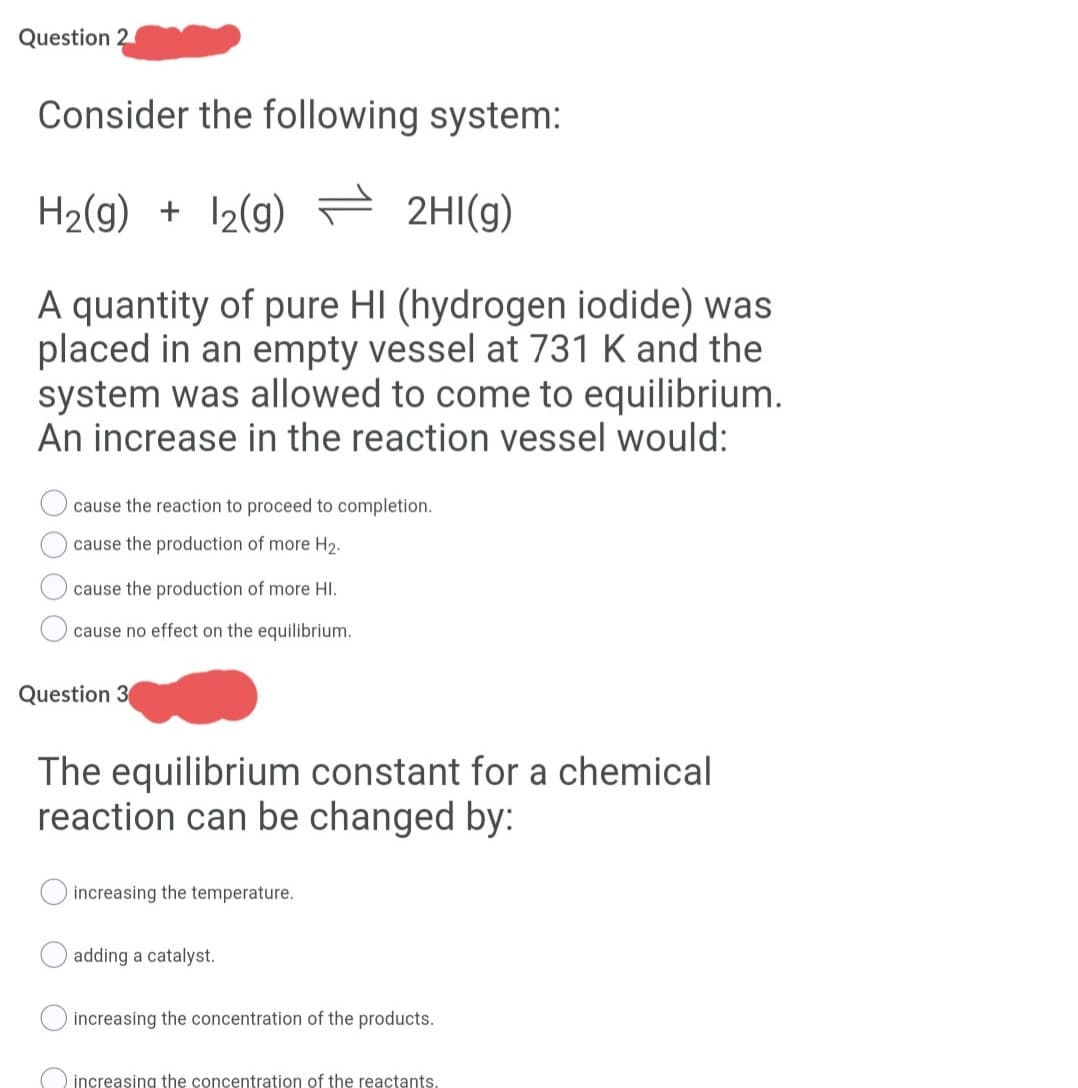Consider the following system: H2(g) + I2(g) H 2HI(g) A quantity of pure HI (hydrogen iodide) was placed in an empty vessel at 731 K and the system was allowed to come to equilibrium. An increase in the reaction vessel would: cause the reaction to proceed to completion. cause the production of more H2. cause the production of more HI. cause no effect on the equilibrium. Question 3 The equilibrium constant for a chemical reaction can be changed by: O increasing the temperature. adding a catalyst. O increasing the concentration of the products. O increasing the concentration of the reactants OOOO
Consider the following system: H2(g) + I2(g) H 2HI(g) A quantity of pure HI (hydrogen iodide) was placed in an empty vessel at 731 K and the system was allowed to come to equilibrium. An increase in the reaction vessel would: cause the reaction to proceed to completion. cause the production of more H2. cause the production of more HI. cause no effect on the equilibrium. Question 3 The equilibrium constant for a chemical reaction can be changed by: O increasing the temperature. adding a catalyst. O increasing the concentration of the products. O increasing the concentration of the reactants OOOO
Chemistry: The Molecular Science
5th Edition
ISBN:9781285199047
Author:John W. Moore, Conrad L. Stanitski
Publisher:John W. Moore, Conrad L. Stanitski
Chapter12: Chemical Equilibrium
Section: Chapter Questions
Problem 74QRT
Related questions
Question
I need 2 and 3 options

Transcribed Image Text:Question 2
Consider the following system:
H2(g) + 12(g) 2HI(g)
A quantity of pure HI (hydrogen iodide) was
placed in an empty vessel at 731 K and the
system was allowed to come to equilibrium.
An increase in the reaction vessel would:
cause the reaction to proceed to completion.
cause the production of more H2.
cause the production of more HI.
cause no effect on the equilibrium.
Question 3
The equilibrium constant for a chemical
reaction can be changed by:
increasing the temperature.
adding a catalyst.
increasing the concentration of the products.
increasing the concentration of the reactants.
Expert Solution
This question has been solved!
Explore an expertly crafted, step-by-step solution for a thorough understanding of key concepts.
This is a popular solution!
Trending now
This is a popular solution!
Step by step
Solved in 2 steps

Knowledge Booster
Learn more about
Need a deep-dive on the concept behind this application? Look no further. Learn more about this topic, chemistry and related others by exploring similar questions and additional content below.Recommended textbooks for you

Chemistry: The Molecular Science
Chemistry
ISBN:
9781285199047
Author:
John W. Moore, Conrad L. Stanitski
Publisher:
Cengage Learning

Chemistry & Chemical Reactivity
Chemistry
ISBN:
9781337399074
Author:
John C. Kotz, Paul M. Treichel, John Townsend, David Treichel
Publisher:
Cengage Learning

Chemistry & Chemical Reactivity
Chemistry
ISBN:
9781133949640
Author:
John C. Kotz, Paul M. Treichel, John Townsend, David Treichel
Publisher:
Cengage Learning

Chemistry: The Molecular Science
Chemistry
ISBN:
9781285199047
Author:
John W. Moore, Conrad L. Stanitski
Publisher:
Cengage Learning

Chemistry & Chemical Reactivity
Chemistry
ISBN:
9781337399074
Author:
John C. Kotz, Paul M. Treichel, John Townsend, David Treichel
Publisher:
Cengage Learning

Chemistry & Chemical Reactivity
Chemistry
ISBN:
9781133949640
Author:
John C. Kotz, Paul M. Treichel, John Townsend, David Treichel
Publisher:
Cengage Learning

Chemistry: An Atoms First Approach
Chemistry
ISBN:
9781305079243
Author:
Steven S. Zumdahl, Susan A. Zumdahl
Publisher:
Cengage Learning


Chemistry
Chemistry
ISBN:
9781305957404
Author:
Steven S. Zumdahl, Susan A. Zumdahl, Donald J. DeCoste
Publisher:
Cengage Learning